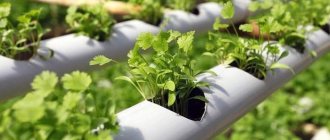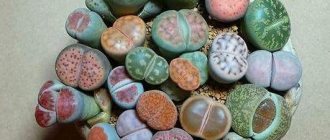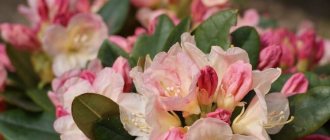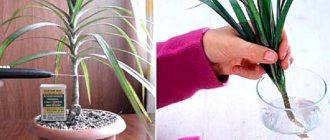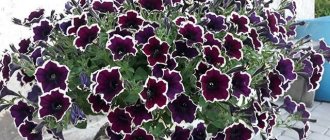The incredible variety of shapes, sizes, colors and textures is what makes succulents so attractive, along with their simplicity. These plants have adapted perfectly to conditions of constant water shortage. Pubescence is one of these devices (by the way, these hairs are called “trichomes”).
Pubescence performs 3 main functions: 1) protects plants from overheating; 2) reduces moisture loss from leaves due to drying wind; 3) protects against being eaten by animals - not everyone likes to eat fluffy foliage.
Haworth's ragwort (Senecio haworthii)
A dwarf perennial from the Asteraceae family, thanks to its original appearance, it has a second name: “Hare Ears”. The entire plant is densely covered with thick white hairs, making the surface appear woolly.
- bush height up to 30 cm, about half a meter in diameter;
- grows very slowly;
- the leaves are green, cigar-shaped and pointed, directed upward.
Under favorable conditions (extremely rare when grown at home), in the summer it produces a fluffy peduncle bearing bright yellow flowers.
@Drew Avery, Flickr
@pokysukkus, Instagram
What flowers are not afraid of drought?
You don’t have the time and opportunity to provide timely watering to your flower beds? Do flowers wither and dry up in the sun? The correct selection of drought-resistant plants that will not lose their appearance and will remain fresh even during the dry period will help solve the problem. These plants came to us from deserts or semi-deserts. Thanks to the special structure of leaves, stems and roots, they are adapted to high temperatures and drought.
If you're not sure whether a plant is adapted to living in dry conditions, look at its leaves. If they are “velvety” or “waxy”, we can say that the crop is adapted to the sun and will forgive you for rare watering.
When the flowerbed is constantly exposed to sunlight, you can decorate it with cheerful flowers. Drought-resistant plants, which are perennial and annual, will help you in this matter. Separately, drought-resistant grasses and shrubs are distinguished.
Drought-tolerant perennials :
- periwinkle;
- coreopsis;
- edelweiss;
- creeping phlox;
- sedums;
- evening primrose;
- sage;
- thrift;
- feverweed;
- splint;
- lavender;
- sagebrush;
- thyme;
- poppies;
- mallows.
Drought-resistant perennials
Drought-resistant annuals :
- annual asters;
- spurge;
- purslane;
- nasturtium;
- amaranth;
- Snapdragon;
- marigold;
- zinnias.
Drought-tolerant annuals
Drought-tolerant grasses and shrubs :
- gray fescue;
- cotoneaster horizontal;
- Cossack and common juniper.
Drought-resistant herbs and shrubs
Even dry, infertile soil, including sandy or rocky soil, is suitable for the growth of the listed plants.
It is impossible to talk in detail about each of the listed plants in one article. Therefore, we will focus on only five of them: echinacea, alpine aster, sedum, thyme and decorative onions. They are beautiful, unpretentious and combine well with each other, so they can be used in landscape design at the same time.
Crassula mesembryanthemoides
A small ground cover plant, unpretentious to grow at home, with a thin fluffy stem. The sessile, oppositely arranged leaves are shaped like a pointed cigar. They are dark green and covered with sparse white downward hairs.
@beleafpottedtreasures, Instagram
@Ernest McGray, Jr., Flickr
Crassula Congesta
An attractive perennial that forms short, erect stems, up to 20 cm high, densely dotted with fleshy, triangular, pointed leaves.
- the color is light green or grayish, with a whitish velvety coating;
- In bright light, the foliage may take on a brownish tan.
It blooms with small white flowers collected in a large inflorescence - a cap. After flowering, the aboveground part dies off.
@plantmomeg, Instagram
@savedbysucculents, Instagram
Planting and care in open ground
The longflower is incredibly easy to care for, which is difficult to assume based on its highly decorative appearance.
Requirements for a place to plant ageratum
It is better to choose an area in the garden that will be protected from drafts, but at the same time well lit.
Note! In general, ageratum will feel quite comfortable in the shade, but the intensity of flowering will decrease, and the shoots may stretch out unsightly.
Soil for the plant
Ageratum has few requirements for the composition of the soil. The main thing is that the soil is moderately nutritious and loose and conducts moisture well without retaining it.
Watering
Regular watering is important for beautiful flowering of ageratum, but between water procedures the top layer of soil must have time to dry .
How to feed ageratum
During the active growing season, ageratum is fed three times . The first feeding is carried out a couple of weeks after planting.
The second time fertilizer is applied at the moment of formation of buds, the third feeding is carried out in the middle of summer and it is not important. For fertilizing, it is worth alternating mineral complexes and organic fertilizers .
Note! The use of nitrogen-containing fertilizers after the appearance of buds can significantly reduce the effectiveness of flowering. Ageratum will grow green mass rather than produce buds.
Trimming and pinching
To form a more lush bush, it is recommended to pinch the tops of the shoots .
Ageratum does not need to form a crown, but regular removal of faded inflorescences and damaged shoots will help preserve the flowering and attractive appearance of the plant longer.
Weeding
Removing weeds is a necessary hygienic procedure . It should be carried out after watering along with loosening the top layer of soil.
Care after flowering
In the fall, when night temperatures drop noticeably, the bush can be dug up and transplanted into a pot .
In this form, the flowering of ageratum can be extended for another couple of months, and in the spring cuttings can be prepared for vegetative propagation of the longflower.
Echeveria pulvinata
Forms an almost stemless large rosette of pointed leaves. The height of the plant is no more than 12 cm, the diameter of the rosette is up to 13 cm. The leaf blade is slightly concave, light green in color with a red tip. It is covered with short white hair, making the plant velvety to the touch.
Echeveria pulvinata 'Ruby' @kakteenhaage, Instagram
Echeveria pulvinata 'Frosty' @kakteenhaage, Instagram
Echeveria Doris Taylor
Hybrid from crossing Echeveria pulvinata and Echeveria setosa.
The compact succulent is formed by a branched bush with a short woody stem and branches growing to the sides. The ends of the shoots are crowned with small (up to 5 cm) dense leaf rosettes of bright green color. The leaf is pointed, elongated, covered with short white hair, thicker on young growth.
@sukulen_house, Instagram
@eastcoastplanthoarder, Instagram
Delosperma echinatum
The succulent belongs to the Aizaceae family and is found naturally in Africa.
The bush is erect, at home not exceeding a height of 30 cm. Its leaves are quite large compared to the thin stem, cylindrical and pointed, light green. The surface of the leaf is covered with nodules - warts, some of them are crowned with white prickly hairs.
The flower is yellow and resembles a burdock bud.
@阿橋 HQ, Flickr
Pests and diseases
The longflower has good immunity, but if the maintenance conditions are violated (excessive watering and low temperature), fungal infections and rot can develop .
In addition to them, cucumber mosaic and bacterial wilt . For bacterial infections, the drug “Fitosporin” is used; mosaic can be defeated by regular treatments with karbofos.
Root rot can be stopped by replanting the flower in a pot with fresh soil and revising the watering regime.
Among the pests that pose a threat to ageratum are:
- aphid;
- spider mite;
- whitefly;
- scoop;
- nematode.
Insecticide treatments will help control parasites.
Read about other plants to decorate your garden:
Kochia - fluffy balls of summer cypress
Phlox subulate: 10 popular garden varieties
Astilbe - a unique shade-loving perennial, 21 photos
Kalanchoe beharensis
A tree-like succulent grown at home not only as an ornamental plant, but also as a medicinal plant. Forms a bush with a straight thick stem, 30-35 cm high.
Very large triangular or oval pointed leaves are olive green. They are velvety to the touch due to the short pile on their surface. The pile has a reddish tint on the front side of the sheet and silvery underneath.
@santacruzsucculents, Instagram
@Ezequiel Coelho, Flickr
Reproduction of ageratum
The plant is propagated:
- seeds;
- rooting cuttings.
Planting ageratum with seeds
To get flowering in late spring, you should try growing ageratum seedlings.
Planting material
Seeds collected from plants in the garden are stored in a cool, dry place. However, it is not a fact that plants grown from such seeds will retain the characteristics of the mother bush.
to use seeds purchased in a store to grow seedlings .
Growing from seeds
The timing of planting seeds for seedlings is March–April . The procedure for growing seedlings does not present any particular difficulties.
Preparing containers and soil
For growing, containers that are not too deep are selected, provided with drainage holes to remove excess moisture.
The soil should be moderately loose and light , but at the same time contain a sufficient amount of nutrients. You can prepare a mixture of turf soil, peat and sand, taken in equal proportions.
Sowing
Before planting, moisten the soil with a spray bottle. The seeds are distributed over the surface of the soil, lightly sprinkling the surface with soil. The container is covered with film or glass.
Temperature
The container is placed in a warm place with a constant air temperature of about 22 °C. As for lighting, it is better to avoid direct sunlight on the plantings, but the light level should be quite high.
Watering
Water ageratum crops with a spray bottle as needed , but not before the top layer of soil dries.
Picking
After the shoots appear, the cover is removed from the container. When the seedlings have two true leaves, you need to pick the sprouts from a common container into individual pots.
Hardening
Two weeks before planting in the ground, seedlings begin to harden off. For a short time, the pots are taken out onto the balcony or terrace, gradually increasing the time spent in the open air.
What is the best way to propagate ageratum - by seeds or cuttings?
In terms of labor costs, both methods are approximately the same . But cuttings with a 100% guarantee allow you to preserve the characteristics of the mother plant, while growing from seeds gives unpredictable, although sometimes very interesting results.
Somali Cyanotis (Cyanotis somaliensis)
Tropical perennial from the Commelinaceae family. Numerous creeping shoots of the plant are dotted with elongated, pointed leaves of bright green color. Along the edge and on the underside they are covered with long white hairs. It blooms with small bright blue flowers.
@FarOutFlora, Flickr
@slogrowers, Instagram
Plectranthus tomentosa
Representative of the Lamiaceae family. The second name - “indoor mint” - was given to the flower for the pronounced minty aroma emanating from the leaves, if you touch them.
The bush is multi-stemmed, with long drooping shoots and numerous rounded green leaves with a wavy edge. Each leaf and stem is covered with sparse colorless hairs.
Important! The flower is very light-loving. When there is a lack of lighting, it stretches out greatly.
@succulentsdepot.com
Alpine asters - a drought-resistant perennial for a flower bed in a sunny place
These are profusely flowering plants. At the beginning of summer, low, neat bushes delight the eye with blossoming simple and semi-double baskets of multi-colored flowers.
Of course, the flowers of alpine asters are not as large and lush as those of their annual “brothers”; they are more reminiscent of daisies, but this does not make them any worse. Alpine varieties of asters require little care and tolerate drought well, even blooming during the hottest summer months.
Alpine asters
The best varieties:
- Albus;
- Goliath;
- Superbus;
- Gloria;
- Rosea.
Asters love loose alkaline soils with a high calcium content.
Bushes can “sit” in one place for 3 years.
In the spring, as well as when transplanting and pruning, potassium-containing preparations and phosphorus should be added to the soil.
Kalanchoe mysterious 'Copper Spoons' (Kalanchoe orgyalis)
Translated, the name means “Copper Spoon,” which refers to the unique shape and color of the succulent’s leaves. The leaf plate seems to be covered with a copper-golden velvet coating on the front part. This coloring is most pronounced on young growth; with age, the foliage becomes green.
It blooms with paniculate yellow inflorescences.
@entireleaves, Flickr
@jayteez, Flickr

